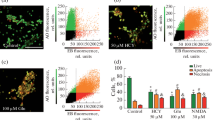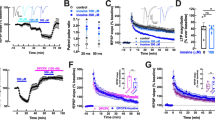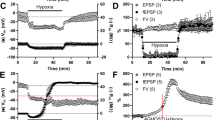Abstract
The inhibitory neuromodulator adenosine has been thought to act as an endogenous neuroprotectant against cerebral ischemia and neuronal damage. The release of preloaded [3H]adenosine from hippocampal slices from developing (7-day-old) and adult (3-month-old) mice was characterized using a superfusion system under various cell-damaging conditions, including hypoxia, hypoglycemia, ischemia, oxidative stress, and the presence of free radicals and metabolic poisons. The release of adenosine was greatly potentiated under the above conditions at both ages, with free radicals, metabolic poisons, and ischemia generally having the strongest stimulatory effects. Depolarization by K+ ions (50 mM) could then evoke more release of adenosine only in the immature hippocampus. Omission of Ca2+ from the superfusion media had no effect on the ischemia-induced release in the adults, indicating that it occurs by a Ca2+-independent system. In contrast, the release in the immature hippocampus was partially dependent on extracellular Ca2+. Furthermore, the ischemia-induced adenosine release was reduced in Na+-deficient media and enhanced by ouabain at both ages, pointing to the involvement of Na+-dependent transporters. The release was also reduced by Cl− channel blockers, thus indicating that a part of the evoked release occurs through anion channels. Another inhibitory neuromodulator and cell volume regulator, taurine, was seen to enhance adenosine release in ischemia at both ages. The simultaneous release of taurine and adenosine under cell-damaging conditions could constitute an important protective mechanism against excessive amounts of excitatory amino acids, counteracting their harmful effects and preventing excitation from reaching neurotoxic levels.
Similar content being viewed by others
REFERENCES
Cunha, R. A. 2001. Adenosine as a neuromodulator and as a homeostatic regulator in the nervous system: Different roles, different sources and different receptors. Neurochem. Int. 38:107-125.
Latini, S. and Pedata, F. 2001. Adenosine in the central nervous system: Release mechanisms and extracellular concentrations. J. Neurochem. 79:463-484.
Haas, H. L. and Greene, R. W. 1998. Endogenous adenosine inhibits hippocampal CA1 neurones: Further evidence from extra-and intracellular recording. Naunyn Schmiedeberg's Arch. Pharmacol. 337:561-565.
Psarropoulou, C., Kostopoulos, G., and Haas, H. L. 1990. An electrophysiological study of the ontogenesis of adenosine receptors in the CA1 area of rat hippocampus. Dev. Brain Res. 55:147-150.
Daval, J.-L., Werck, M. C., Nehlig, A., and Pereira de Vasconcelos, A. 1991. Quantitative autoradiographic study of the postnatal development of adenosine A1 receptors and their coupling to G proteins in the rat brain. Neuroscience 40:841-851.
Dragunow, M. and Faull, R. L. 1988. Neuroprotective effects of adenosine. Trends Pharmacol. Sci. 9:193-194.
Deckert, J. and Gleiter, C. H. 1994. Adenosine: An endogenous neuroprotective metabolite and neuromodulator. J. Neural Transm. 43:Suppl., 23-31.
Saransaari, P. and Oja, S. S. 2002. Mechanisms of adenosine release in the developing and adult mouse hippocampus. Neurochem. Res. 27:911-918.
Saransaari, P. and Oja, S. S. 2000. Taurine and neural cell damage. Amino Acids 19:509-526.
Kontro, P. and Oja, S. S. 1987. Taurine and GABA release from mouse cerebral cortex slices: Potassium stimulation releases more taurine than GABA from developing brain. Dev. Brain Res. 37:277-291.
Sturman, J. A. 1993. Taurine in development. Physiol. Rev. 73:119-147.
Doble, A. 1996. The pharmacology and mechanism of action of riluzole. Neurology 47:S233-S241.
Hamill, O. P. and McBride, D. W. Jr. 1996. The pharmacology of mechanogated membrane ion channels. Pharmacol. Rev. 48:231-252.
Agostinho, P., Duarte, C. B., Carvalho, A. P., and Oliveira, C. R. 1994. Effect of oxidative stress on the release of [3H]GABA in cultured chick retina cells. Brain Res. 655:213-221.
Gilman, S. C., Bonner, M. J., and Pellmar, T. C. 1994. Free radicals enhance basal release of D-[3H]aspartate from cerebral cortical synaptosomes. J. Neurochem. 62:1757-1763.
Haddad, G. G. and Jiang, C. 1993. O2 deprivation in the central nervous system: On mechanisms of neuronal response, differential sensitivity and injury. Prog. Neurobiol. 40:277-318.
Hara, H., Sukamoto, T., and Kogure, K. 1993. Mechanism and pathogenesis of ischemia-induced neuronal damage. Prog. Neurobiol. 40:645-670.
Fowler, J. C. 1993. Changes in extracellular adenosine levels and population spike amplitude during graded hypoxia in the rat hippocampal slice. Naunyn Schmiedeberg's Arch. Pharmacol. 347:73-78.
Pedata, F., Latini, S., Pugliese, A. M., and Pepeu, G. 1993. Investigations into the adenosine outflow from hippocampal slices evoked by ischemia-like conditions. J. Neurochem. 61:284-289.
Latini, S., Bordoni, F., Corradetti, R., Pepeu, G., and Pedata, F. 1998. Temporal correlation between adenosine outflow and synaptic potential inhibition in rat hippocampal slices during ischemia-like conditions. Brain Res. 794:325-328.
Latini, S., Bordoni, F., Pedata, F., and Corradetti, R. 1999. Extracellular adenosine concentrations during in vitro ischaemia in rat hippocampal slices. Br. J. Pharmacol. 127:729-739.
Lucchi, R., Latini, S., de Mendonca, A., Sebastiao, A. M., and Ribeiro, J. A. 1996 Adenosine by activating A1 receptors prevents GABAA-mediated actions during hypoxia in the rat hippocampus. Brain Res. 732:261-266.
Mori, M., Nishizaki, T., and Okada, Y. 1992. Protective effect of adenosine on the anoxic damage of hippocampal slice. Neuroscience 46:301-307.
Andine, P., Rudolphi, K. A., Fredholm, B. B., and Hagberg, H. 1990. Effect of propentofylline (HWA 285) on extracellular purines and excitatory amino acids in CA1 of rat hippocampus during transient ischaemia. Br. J. Pharmacol. 100: 814-818.
Dux, E., Fastbom, J., Ungerstedt, U., Rudolphi, K., and Fredholm, B. B. 1990. Protective effect of adenosine and a novel xanthine derivative propentofylline on the cell damage after bilateral carotid occlusion in the gerbil hippocampus. Brain Res. 516:248-256.
Pellmar, T. C., Neel, K. L., and Lee, K. H. 1989. Free radicals mediate peroxidative damage in the guinea pig hippocampus in vitro. J. Neurosci. Res. 24:437-444.
O'Regan, M. H., Smith-Barbour, M., Perkins, L. M., and Phillis J. W. 1995. A possible role for phospholipases in the release of neurotransmitter amino acids from ischemic rat cerebral cortex. Neurosci. Lett. 185:191-194.
Insel, T. R., Miller, L. P., and Gelhard, R. E. 1990. The ontogeny of excitatory amino acid receptors in rat forebrain. I. N-Methyl-D-aspartate and quisqualate receptors. Neuroscience 35:31-43.
McDonald, J. W., Johnston, M. V., and Young, A. B. 1990. Differential ontogenic development of three receptors comprising the NMDA receptor/channel complex in the rat hippocampus. Exp. Neurol. 110:237-247.
Le Grevés, P., Hoogendoorn, K., Synnergren, B., Meyerson, B., and Myberg, F. 1996. The relationship between the NMDA receptor NR1 subunit mRNA and [3H]MK-801 binding in the embryonic and early postnatal rat CNS. Neurosci. Res. Commun. 19:145-152.
Colwell, C. S., Cepeda, C., Crawford, C., and Levine, M. S. 1998. Postnatal development of glutamate receptor-mediated responses in the neostriatum. Dev. Neurosci. 20:154-163.
Craig, C. G. and White, T. D. 1993. N-Methyl-D-aspartate-and non-N-methyl-D-aspartate-evoked adenosine release from rat cortical slices: distinct purinergic sources and mechanisms of release. J. Neurochem. 60:1073-1080.
Saransaari, P. and Oja, S. S. 1998. Release of endogenous glutamate, aspartate, GABA and taurine from hippocampal slices from adult and developing mice in cell-damaging conditions. Neurochem. Res. 23:567-574.
Sánchez-Prieto, J., Sihra, T. S., and Nicholls, D. G. 1987. Characterization of the exocytotic release of glutamate from guineapig cerebral cortical synaptosomes. J. Neurochem. 49:58-64.
Saransaari, P. and Oja, S. S. 1999. Mechanisms of D-aspartate release under ischemic conditions in mouse hippocampal slices. Neurochem. Res. 24:1009-1016.
Korpi, E. R. and Oja, S. S. 1983. Characteristics of taurine release from cerebral cortex slices induced by sodium-deficient media. Brain Res. 289:197-204.
Parkinson, F. E., Rudolphi, K. A., and Fredholm, B. B. 1994. Propentofylline: A nucleoside transport inhibitor with neuroprotective effects in cerebral ischemia. Gen. Pharmacol. 25:1053-1058.
Sweeney, M. I. 1996. Adenosine release and uptake in cerebellar granule neurons both occur via an equilibrative nucleoside carrier that is modulated by G proteins. J. Neurochem. 67:81-88.
Somjen, G. G., Aitken, P. G., Balestrino, M., Herreras, O., and Kawasaki, K. 1990. Spreading depression-like depolarization and selective vulnerability of neurons. Brief review. Stroke 21:179-183.
Schousboe, A., Sánchez Olea, R., Morán, J., and Pasantes-Morales, H. 1991. Hyposmolarity-induced taurine release in cerebellar granule cells is associated with diffusion and not with high-affinity transport. J. Neurosci. Res. 30:661-665.
Phillis, J. W., Song, D., and O'Regan, M. H. 1997. Inhibition by anion channel blockers of ischemia-evoked release of excitotoxic and other amino acids from rat cerebral cortex. Brain Res. 758:9-16.
Oja, S. S. and Saransaari, P. 1996. Taurine as osmoregulator and neuromodulator in the brain. Metab. Brain Dis. 11:153-164.
Trenkner, E. 1990. The role of taurine and glutamate during early postnatal cerebellar development of normal and weaver mutant mice. Adv. Exp. Med. Biol. 268:239-244.
Schurr, A., Tseng, M. T., West, C. A., and Rigor, B. M. 1987. Taurine improves the recovery of neuronal function following cerebral hypoxia: An in vitro study. Life Sci. 40:2059-2066.
Lehmann, A., Hagberg, H., Nyström, B., Sandberg, M., and Hamberger, A. 1985. In vivo regulation of extracellular taurine and other neuroactive amino acids in rabbit hippocampus. Prog. Clin. Biol. Res. 179:289-311.
Varga, V., Janáky, R., and Oja, S. S. 1992. Modulation of glutamate agonist-induced influx of calcium into neurons by γ-L-glutamyl and β-L-aspartyl dipeptides Neurosci. Lett. 138:270-274.
Matsumoto, K., Ueda, S., Hashimoto, T., and Kuriyama, K. 1991. Ischemic neuronal injury in the rat hippocampus following transient forebrain ischemia: Evaluation using in vivo microdialysis. Brain Res. 543:236-242.
Boldyrev, A. A., Johnson, P., Wei, Y., Tan, Y., and Carpenter, D. O., 1999. Carnosine and taurine protect rat cerebellar granular cells from free radical damage. Neurosci. Lett. 263:169-172.
Oja, S. S. and Kontro, P. 1983. Free amino acids in epilepsy: Possible role of taurine. Acta Neurol. Scand. 67(Suppl 93):5-20.
Globus, M. Y.-T., Busto, R., Dietrich, W. D., Martinez, E., Valdes, I., and Ginsberg, M. D. 1988. Effect of ischemia on the in vivo release of striatal dopamine, glutamate and γ-aminobutyric acid studied by intracerebral microdialysis. J. Neurochem. 51:1455-1464.
Szatkowski, M. and Attwell, D. 1994. Triggering and execution of neuronal death in brain ischemia: Two phases of glutamate release by different mechanisms. Trends Neurosci. 17:359-365.
Saransaari, P. and Oja, S. S. 1997. Enhanced GABA release in cell-damaging conditions in the adult and developing mouse hippocampus. Int. J. Dev. Neurosci. 15:163-174.
Saransaari, P. and Oja, S. S. 1997. Enhanced taurine release in cell-damaging conditions in the developing and ageing mouse hippocampus. Neuroscience 79:847-854.
Saransaari, P. and Oja, S. S. 1999. β-Alanine release from the adult and developing hippocampus is enhanced by ionotropic glutamate receptor agonists and cell-damaging conditions. Neurochem. Res. 24:407-414.
Oja, S. S., Korpi, E. R., and Saransaari, P. 1990. Modification of chloride flux across brain membranes by inhibitory amino acids in developing and adult mice. Neurochem. Res. 15:797-804.
Author information
Authors and Affiliations
Corresponding author
Rights and permissions
About this article
Cite this article
Saransaari, P., Oja, S.S. Enhanced Release of Adenosine Under Cell-Damaging Conditions in the Developing and Adult Mouse Hippocampus. Neurochem Res 28, 1409–1417 (2003). https://doi.org/10.1023/A:1024956701683
Issue Date:
DOI: https://doi.org/10.1023/A:1024956701683




